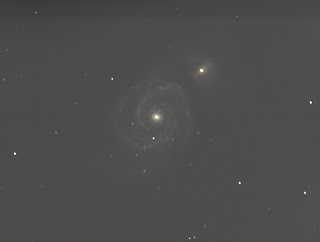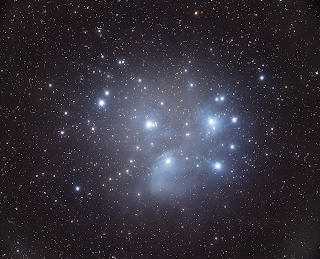First Light Celestron CGX 1100 Edge HD
June 24, 2020:
Today I was able to pick up the new Celestron CGX 1100 Edge HD. At home I immediately installed and adjusted the polar finder. Then I mounted the optics and balanced the whole thing. Then the finderscope is adjusted to the main optics.
Unfortunately I didn't have the right screws to mount the StarSense. Either they were too long or too short ...
When it was finally dark I had to do a manual alignment. First I aligned the polar finder as precisely as possible to the north and then carried out a 2-star alignment. For some reason, the finderscope was no longer properly aligned with the main optics. That made it very difficult to find the star with the main optics. Therefore, the whole alignment took a long time.
Besides, I probably hadn't done it well either. In any case, I positioned the scope on the M 27, but saw nothing in the image field. The plate solving with Voyager also broke off and could not determine the position. Then I tried it with the M 51, which was also not visible in the image field. But Voyager was then able to position precisely using plate solving, but had to correct it relatively strongly.
Then I took a picture with 7 x 2 minutes exposure time:
M 51: Atik Horizon 7x120s stacked with Atik Infinity and no further processing
The stars already looked much better than in the previous photos.
June 25, 2020:
Today I got myself longer screws so that I could mount the StarSense. At the same time I wanted to check the collimation with the Baader Laser Coli Mk III. The laser was on the very edge, i.e. the telescope collimates poorly. I corrected it immediately and collimated it so that the laser was right in the center. Then I installed the Celestron focus motor. Then I made a firmware update of all components.
In the evening I set up with the StarSense. When I wanted to focus on a star, the blurred star looked bad at times (i.e. very badly collimated). But since I had collimated with the laser, I ignored it. Then I positioned myself on the M 27. Despite the large focal length, the M 27 was exactly in the center of the field of view (the positioning has never worked so precisely until now). But after the first picture the big disappointment. It looked as bad as the pictures earlier.
This means that collimation was actually the problem with the previous images. And unfortunately also that the Laser Coli Mk III is obviously poorly adjusted and therefore unusable.
I then carried out a collimation using a star and then photographed the M27:
M 27: Atik Horizon 205x30s stacked with Atik Infinity.
The stars look much better here, but are not yet perfect. On the Internet I found a very good article on collimation: http://www.astrophoto.fr/collim.html
June 30, 2020:
According to these instructions, I was able to carry out steps 1 and 2. Since I even had to correct something in step 1, it should be clear that the next photo will be better than the one from M 27 on June 25, 2020.
I then briefly looked at the moon, Jupiter and Saturn and took pictures behind the eyepiece with my cell phone:
June 30, 2020: Huawei P30 Pro behind the eyepiece
From the photo of the moon (I was amazed how good it was with the cell phone) you can see that the sharpness is probably quite good. However, the pictures of Jupiter and Saturn with the cell phone were not so good. But I think the next pictures should be very good.
Then I switched back to photography and set everything up so that the 146mm back focus is perfect. Now I'm extremely excited to see how the next pictures will be.






Comments
Post a Comment